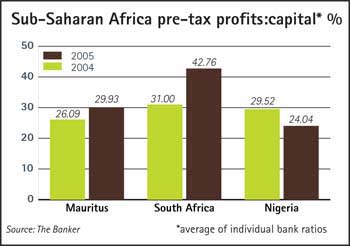At the deadline of December 31, 2005, 25 banks had met the requirement, in the process culling the banking system down from 89 mostly weak and ailing institutions.
The Top 1000 will be sobering reading for Nigeria’s central bank governor Charles Soludo. He told The Banker he would like to see a Nigerian bank in the Top 100 world banks, if not the Top 50, within 10 years. This year’s 100th ranked bank, Shinsei Bank of Japan, has Tier 1 capital of $6.3bn, almost 19 times the size of Nigeria’s biggest bank, First Bank of Nigeria, with Tier 1 capital of just $338m. Even if Shinsei Bank’s capital remained unchanged, First Bank of Nigeria would have to grow its core capital by more than 33% a year to match Shinsei in 10 years. (The 50th ranked bank, Resona Holdings, also of Japan, has almost double the Tier 1 capital again, with $12.1bn.)
For Mr Soludo to realise his ambition that Nigeria becomes the financial hub of Africa, he first has to catch up with South Africa, whose banks are easily the largest on the continent, occupying the top five positions on the list of sub-Saharan African banks.
South Africa’s dominance would be even more manifest were it not for the fact that Absa, the country’s second biggest bank, was acquired by UK-headquartered Barclays.
Aside from Absa, the main change to the ranking of South African banks is that Investec overtakes FirstRand. For a long time considered a relative minnow to the country’s traditional ‘Big Four’ banks – Standard, Absa, Nedcor and FirstRand – Investec’s Tier 1 capital surged more than 44% on last year. That said, all the Tier 1 figures for the South African banks suffer from the translation impact of the relative volatility of the rand to the dollar.
An interesting name to watch is African Bank, a South African lender that provides credit to low-income customers. The bank continues to show the way in extending services to under-banked segments of the market, lengthening its track record of profitability without compromising financial soundness.
With Africa’s formal sector banking market tiny in world terms, tapping higher risk, lower margin markets will be key to growth.











